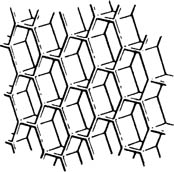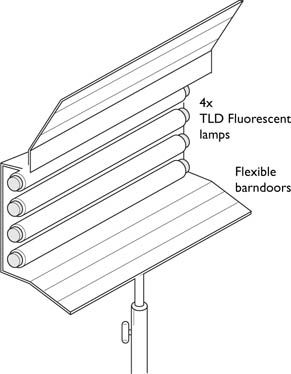The use of high-frequency fluorescent lights has become a viable option both in studios and on location. The merits of such lights compared to tungsten are:
• |
greater efficiency, or more correctly efficacy, producing 3 to 4 times more light than tungsten sources. Tungsten halogen produces 25 lumens/watt, whereas fluorescent lamps, depending on type, can produce up to 100 lumens/watt. |
• |
no radiant heat in the light beam, unlike tungsten sources which radiate typically 55% of lamp power in the beam. This means the artistes are more comfortable under cold light sources. |
• |
fluorescent luminaires usually use several lamps to produce a practical light source, hence they are soft sources, i.e. not point sources. This results in less glare for the artistes, again, adding to their comfort. Control of the light beam shape is either by a fine structured ‘egg-crate’ or ‘honeycomb’ fitment. |
In recent years the development of improved phosphors has made the fluorescent lamp acceptable for television and film. Phosphors are available to provide tungsten matching and daylight matching colour temperatures. This is a distinct advantage on location; one can simply change the fluorescent tubes to suit the environment.
Ballast
The use of high-frequency dimmable ballasts operating above 40 kHz provides:
• |
a flicker free output |
• |
dimming with a simple 0–10 V control (or 100kΩ potentiometer) to achieve reduction in lighting levels with little change in colour (unlike dimmed tungsten sources). |
Luminaires have been developed using:
(a) |
40 W tubular lamps |
(b) |
55 W and 33 W biaxial lamps |
(c) |
26 W com-quad lamps |
(d) |
32 W triple biaxial lamps. |
(b), (c) and (d) are compact fluorescent lamps (CFL).
Most location based luminaires use (a) and (b), enabling a compact structure to be made of large area but small depth. Some luminaires operate with a separate ballast to reduce weight.
Another advantage of cold light sources is the ability to touch and de-rig the luminaires immediately the shoot has finished – very little heat is generated.

Control of light beam spread is by means of a honeycomb type screen over the front of the fixture. The degree of control depends on the depth of the honeycomb or the area of the apertures: typically 90°, 60° or 30°. Alternatives to using control screen are egg-crates, barndoors or flags.
There are two basic types of fluorescent luminaire, one uses the conventional tubular lamps (TL-D), the other uses the compact fluorescent lamps (PL-L and PL-C). Like all discharge lights the fluorescent luminaire includes a current limiting ballast in addition to auxiliary electronics for starting. The ballast also includes the necessary electronics to drive the lamps at high frequency (>40 kHz). The luminaires using the TL-D lamps were designed for use mainly on location. They are made with a separate ballast, usually dimmable, to provide an extremely lightweight and thin softlight, ideal for use in cramped conditions.
Colour rendition index Ra
A method of comparing the colour fidelity and consistency of a light source has been devised using a scale of 0 to 100.The colour rendition index Ra can be used as indication of the suitability for use in television production with an Ra of 70 regarded as the lower limit of acceptability for colour television.

